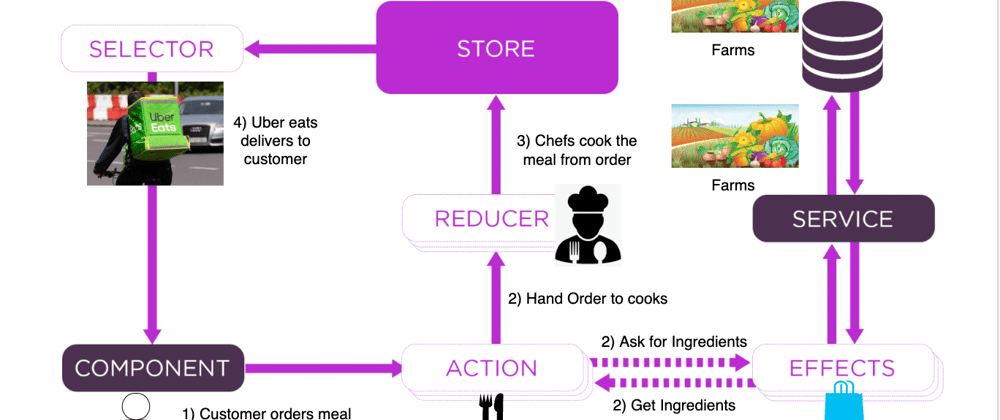From Zero to Hero with NGRX: Crafting a CRUD Application in Angular
Introduction
Are you looking to build a powerful CRUD (Create, Read, Update, Delete) application with Angular? Look no further. In this tutorial, we'll dive into leveraging NGRX, a state management library for Angular applications, to create a robust CRUD app. With NGRX, you'll be able to efficiently manage state, handle side effects, and ensure a seamless user experience. So, let's roll up our sleeves and embark on this journey to mastering NGRX.
Understanding NGRX
What is NGRX?
NGRX is a state management library inspired by Redux for Angular applications. It follows a unidirectional data flow architecture, which helps in maintaining a predictable state of your application.
Why Use NGRX?
NGRX provides a centralized store for managing state, which leads to better organization and scalability of your codebase. It also facilitates the handling of complex data flows and asynchronous operations with ease.
How Does NGRX Work?
NGRX operates based on the principles of actions, reducers, effects, and selectors. Actions are dispatched to trigger state changes, reducers specify how the state should change in response to actions, effects handle side effects such as asynchronous operations, and selectors provide a way to efficiently extract specific pieces of state.
Setting Up Your Angular Project
Before diving into the CRUD operations, let's set up our Angular project with NGRX.
- Create a new Angular project: Use Angular CLI to generate a new Angular project.
ng new my-crud-app
- Install NGRX dependencies: Install the necessary NGRX packages.
npm install @ngrx/store @ngrx/effects @ngrx/entity @ngrx/router-store @ngrx/store-devtools --save
- Set up the store: Configure the NGRX store in your Angular application.
// app.module.ts
import { StoreModule } from '@ngrx/store';
import { EffectsModule } from '@ngrx/effects';
import { reducers, effects } from './store';
@NgModule({
imports: [
// Other imports
StoreModule.forRoot(reducers),
EffectsModule.forRoot(effects),
],
// Other configurations
})
export class AppModule {}
Implementing CRUD Operations with NGRX
Now that we have our Angular project set up with NGRX, let's proceed to implement CRUD operations.
Creating Actions
Actions define the events that can occur in your application. Let's create actions for each CRUD operation.
// product.actions.ts
import { createAction, props } from '@ngrx/store';
import { Product } from './product.model';
export const addProduct = createAction('[Product] Add', props<{ product: Product }>());
export const updateProduct = createAction('[Product] Update', props<{ product: Product }>());
export const deleteProduct = createAction('[Product] Delete', props<{ id: string }>());
export const loadProducts = createAction('[Product] Load');
export const productsLoaded = createAction('[Product] Loaded', props<{ products: Product[] }>());
export const productsLoadFailed = createAction('[Product] Load Failed', props<{ error: any }>());
Creating Reducers
Reducers specify how the state should change in response to actions. Let's create reducers to handle our product state.
// product.reducer.ts
import { createReducer, on } from '@ngrx/store';
import { EntityState, createEntityAdapter } from '@ngrx/entity';
import { Product } from './product.model';
import * as ProductActions from './product.actions';
export interface ProductState extends EntityState<Product> {}
export const adapter = createEntityAdapter<Product>();
const initialState: ProductState = adapter.getInitialState();
export const productReducer = createReducer(
initialState,
on(ProductActions.productsLoaded, (state, { products }) =>
adapter.setAll(products, state)
),
on(ProductActions.addProduct, (state, { product }) =>
adapter.addOne(product, state)
),
on(ProductActions.updateProduct, (state, { product }) =>
adapter.updateOne({ id: product.id, changes: product }, state)
),
on(ProductActions.deleteProduct, (state, { id }) =>
adapter.removeOne(id, state)
)
);
Creating Effects
Effects handle side effects such as HTTP requests. Let's create effects to fetch, add, update, and delete products.
// product.effects.ts
import { Injectable } from '@angular/core';
import { Actions, ofType, createEffect } from '@ngrx/effects';
import { ProductService } from './product.service';
import { mergeMap, map, catchError } from 'rxjs/operators';
import { of } from 'rxjs';
import * as ProductActions from './product.actions';
@Injectable()
export class ProductEffects {
loadProducts$ = createEffect(() =>
this.actions$.pipe(
ofType(ProductActions.loadProducts),
mergeMap(() =>
this.productService.getProducts().pipe(
map(products => ProductActions.productsLoaded({ products })),
catchError(error => of(ProductActions.productsLoadFailed({ error })))
)
)
)
);
// Other effects for add, update, delete operations
}
Conclusion
In this tutorial, we've explored how to build a robust CRUD application with Angular using NGRX. We've learned about the key concepts of NGRX such as actions, reducers, effects, and selectors, and implemented them to manage the state of our application effectively. By following the principles of NGRX, you can create scalable, maintainable, and efficient Angular applications. So go ahead, apply what you've learned, and elevate your Angular development skills to the next level with NGRX. Happy coding!
FAQs
Q: Is NGRX suitable for small-scale applications?
A: While NGRX is typically used in large-scale applications with complex state management requirements, it can also be beneficial in smaller applications by providing a centralized and predictable state management solution.
Q: How does NGRX compare to other state management solutions in Angular?
A: NGRX is similar to Redux in its principles and usage. However, it is specifically tailored for Angular applications, providing seamless integration with Angular's ecosystem and leveraging RxJS for handling asynchronous operations.
Q: Can NGRX be used with Angular's built-in forms module?
A: Yes, NGRX can be used with Angular's built-in forms module. You can manage form state using NGRX actions, reducers, and selectors, allowing for a consistent approach to managing all aspects of your application's state.
Q: Are there any performance considerations when using NGRX?
A: While NGRX offers powerful state management capabilities, improper usage or overuse of state management can impact performance. It's essential to carefully design your state management architecture and consider factors such as memoization and selective state updates to optimize performance.







Top comments (0)